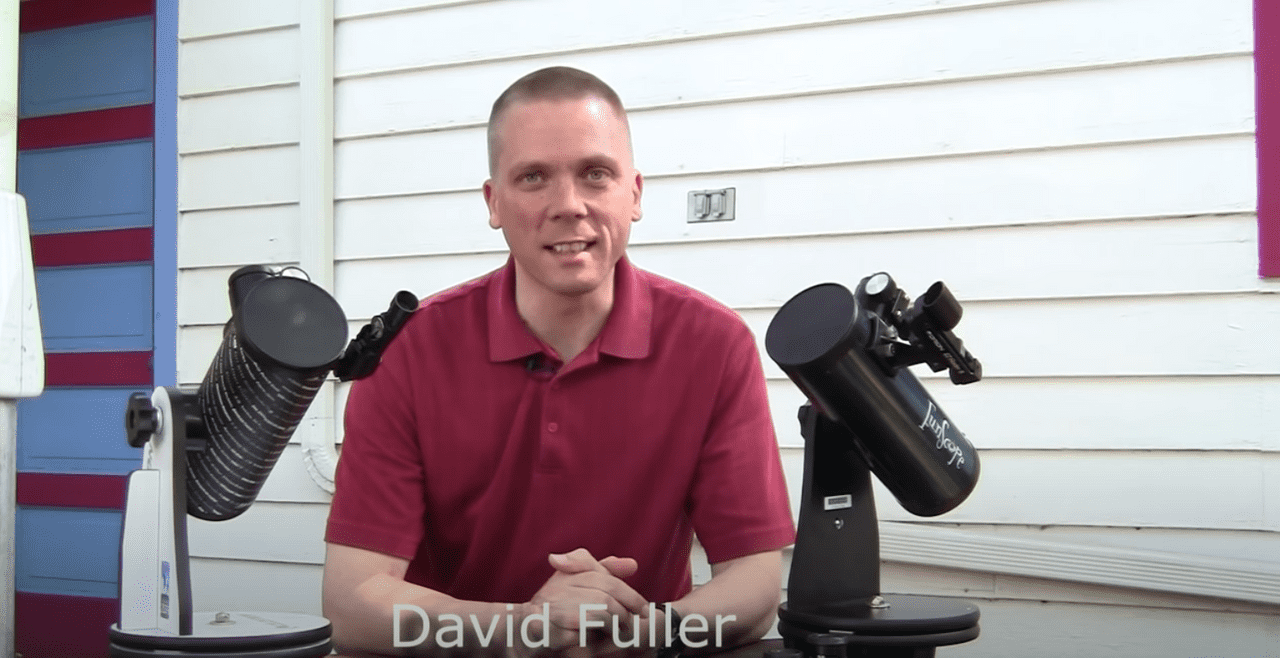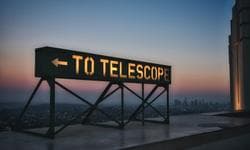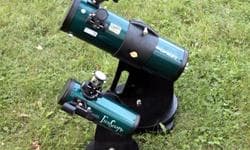
Eyes on the Sky
with David Fuller
with David Fuller

The Best Affordable, Beginner Telescope Options
November 21, 2018
PLEASE READ this information carefully as it takes into account a lot of different factors for many differing requests. If you really don't like to read or watch the video and just want an answer RIGHT NOW, skip to the end for the TL;DR info. Also, when asking a telescope question, start a new post so everyone sees it; otherwise it will get lost in the comments here about this particular post.
First, I would strongly encourage you to learn about telescope types, accessories like eyepieces and barlow lenses, plus how to calculate magnification, understanding telescopic and apparent field of view, and the types plus how to align a finderscope. So that equatorial mounts are not confusing, you can also learn how to align and how to use an equatorial mount will help make those kinds of mounts more easily understood as well. You'll be better informed in about an hour, and (almost) all are closed-captioned so you can read what's said while watching them (for instance, if you're at work... not that anyone does that ever, LOL). ALL OF THAT CAN BE FOUND HERE: http://eyesonthesky.com/Blog/tabid/80/EntryId/179/The-Ultimate-Beginners-Guide-to-Telescopes-and-Amateur-Astronomy.aspx
Okay, on to the telescope-deciding factors.
1. WHAT IS YOUR BUDGET?.
There are amateur telescope options ranging from $35.00 to $35,000. Determine how much you can spend, and keep in mind that a telescope can last for years, so a good one that is a bit more expensive will cost less over time.
2. WHAT ARE YOUR OBSERVING CONDITIONS LIKE, AND WHAT DO YOU WANT TO SEE?
A 70mm telescope under dark skies can show galaxies that you won't see in a dense urban location with a 200mm reflector. If you're okay with just observing the Moon and planets, cool - a very small refractor may be just fine for you.. If you want to observe EVERYTHING, consider that carefully. If you live in a rural, suburban, or urban area, and WHERE you plan to observe from - dark skies only? City AND dark skies? - you will need to account for wanting more aperture if you are under more light pollution.
3. WHAT IS YOUR TOLERANCE FOR COMPROMISES MADE ON RETAIL LEVEL TELESCOPES?
Despite the fact that telescopes are FAR less expensive today than they were 20-30 years ago, there's still price points that retailers are trying to meet. So they cut corners to meet those price points. If you buy a sub-$100 telescope, it will likely have a LOT of corners cut. $300 to $350 is where telescopes START to have a lot fewer corners cut, and the better quality scopes begin.
That's not to say you can't get an adequate scope for less - you can - but you'll need to be aware of some problems it may exhibit: Shakiness of a wobbly tripod because it's too thin for the scope, maybe no tripod at all, optical aberrations like coma or chromatic aberration, too small mounts, too small finderscopes, cheap eyepieces, etc.
One thing that IS true in general is that MOST retail telescopes actually do have decent main optics. The primary lens or mirror is often an acceptable quality. The problem is manufacturers then skimp on everything else on less expensive ones. Your tolerance for those cut corners - and what "handiness" you have (i.e., making/building your own stuff) will determine whether a less expensive scope is something you are willing to purchase.
4. A LIST OF SOME TELESCOPES OFTEN RECOMMENDED, BY PRICE RANGE
Sub $100 PRICE RANGE
Refractor
None worth buying
Reflector
300mm focal length Dobsonian-type reflectors - three versions:
A, Orion Funscope - will need a table/tripod, and very soon require a 2.5x or 3x barlow lens, review here.
B. Skywatcher Heritage 76 is a similar version available in Europe.
C. Celestron has TWO versions of their similarly-made Firstscope, one of which does not include finderscope and is not recommended; the other is the COSMOS Firstscope that DOES come with a red dot finder and two 3-element eyepieces that are better than the 2-element ones included with the lesser Firstscope.
There is little functional difference between them; all work reasonably well. The included finderscope/red dot finder versions are STRONGLY recommended over those that do not include any finder.
$100 to $150 PRICE RANGE
Refractor
Celestron AstroMaster 70AZ - needs better finderscope, eyepieces are inexpensive and have narrow fields of view, tripod is at least marginally adequate, but optics acceptable with low chromatic aberration
Sky-Watcher Mercury 70/700 AZ2 ($100-$150 range) -- better mount and eyepieces than the Celestron's 70AZ, but the viewfinder is almost useless.
Reflector
Orion Skyscanner - no tripod, very short focal length, needs a 2.5x to 3x barlow, but is stable and has generous aperture for a very low cost
Spaceprobe 3 AZ - tripod is low-cost and the bearing surfaces for the altitude and azimuth mounts are small which may make for challenging motions. But it has a forgiving focal ratio, doesn't require a table, and got a decent review by Sky and Telescope magazine for a low cost value scope. Eyepieces are low cost, but the design will work fine given the focal length of the telescope.
Sky-Watcher Astrolux 76/700 ($100-$150 range) -- pretty much same as the Spaceprobe 3, better eyepieces, but the viewfinder is almost useless.
$150 to $200 PRICE RANGE
Refractor
Orion GoSCope 80 - short focal length, needs 2.5x to 3x barlow, chromatic aberration is very noticeable on brighter objects, scope can't view overhead as diagonal hits base. Adequate aperture, very stable.
Celestron Astromaster 70 EQ - Decent optics on decently sized mount/tripod, but may exhibit some vibration. Eyepieces sub-par but acceptable for initial use, finderscope should be replaced with 6x30 or larger
Sky-Watcher StarTravel 80/400 EQ1 tabletop (150-200 range)-- a small, fast focal ratio refractor on a tabletop equatorial mounting. Very portable, but has noticeable chromatic aberration.
Celestron AstroMaster 90AZ 90mm F/11 Achromat on AZ tripod. Very portable, yet big enough to see those rings on Saturn or cloud bands and the GRS on the Jupiter. Plus many of the Messier catalogue objects should be readily visible under sufficiently dark skies. Though the scope may tend to fall backwards at higher altitude angles.
Reflector
HIGHLY RECOMMENDED: Astronomers Without Borders OnesSky telescope (Skywatcher Heritage 130P is identical scope) - Gary Seronik of Sky and Telescope says "I can’t imagine a beginner not being thrilled with the views it provides. It gets my vote for the best bang-for-the-buck beginner’s scope currently available." Still needs a barlow and a table/tripod on which to place it. Also the focuser is helical, not the typical rack and pinion type. May require some work to avoid stray light entering focuser/eyepiece. Overall good value.
Orion Starblast 4.5 - Needs barlow lens and table/tripod. Adequate included optics, but will require eventual upgrades of either barlow lens and/or shorter focal length eyepieces. Coma around edges is apparent, but does provide wide field views.
Meade has 114mm and 130mmm tabletop reflector options well worth considering.
Catadioptric
Orion Starmax 90 Maksutov Cassegrain Star - diagonal hits base, so scope cannot be pointed directly overhead. Excellent higher magnification, but downside is wide field views are harder to obtain. Generally decent optics. May require purchase or making dew shield to avoid dew forming on corrector lens. Includes red dot finder.
$200 to $300 PRICE RANGE
Refractor
Celestron AstroMaster 90 EQ - Adequate tripod and mount. Decent aperture for a refractor. Finderscope and star diagonal are low-cost. Eyepieces are marginally adequte with narrow fields of view. Lack of tube rings means balance cannot be adjusted on scope side. Chromatic aberration moderately well controlled.
Orion Astroblast 90mm Alt-Az - Adequate tripod and mount. Decent aperture for a refractor. Finderscope and diagonal marginally better than Celestrons. Tube rings allow for better balancing, though at f6.7, has more chromatic aberration.
Sky-Watcher Evostar 90/900 (EQ2/AZ3 -- $250-$300, EQ3-2 -- $400-$450) -- similar to the AstroMaster 90 EQ. Available on AZ3 Alt-Az mount (light, solid, sturdy and has slow-mo controls), EQ2 (adequate, but may be a source of vibrations) and EQ3-2 (very solid, excellent for observation, possible for AP, but heavy). The scope itself has decent aperture for a refractor, fairly low CA due to F/10 focal rate, great for planets, average for DSOs. Good (but not fantastic) 6×30 viewfinder.
Reflector
HIGHLY RECOMMENDED: Orion XT4.5 Dobsonian - Another good option for a first telescope, but not motor driven. Optics will produce good images with little to no coma, and are marginally diffraction limited. Includes usefully sized (and not stopped down!) 6x26 correct image finderscope and TWO good quality Plossl-type eyepieces. Excellent value, though small and requires a crate or box to be at adequate height for most teens and adults even with a chair.
$300 to $400 PRICE RANGE
Refractor
Orion 90mm Astroview EQ - Decent aperture for a refractor. Mount and tripod are minimally adequate, but may require some work to avoid vibrations at higher magnifications. 6x26 finder is minimally adequate, and at least is not stopped down internally.
Vixen A70Lf Refractor - While smaller in aperture, this is a good option for the moderately dark-sky site person as Vixen has a superb reputation both for optics and their mounts are quite good.
Reflector
HIGHLY RECOMMENDED: Orion XT6 or XT8 - Many people will say that the best 6" f/8 telescope is an 8" f/6. But don't neglect the weight, size, and less collimation required for a 6" scope. An f/8 is more forgiving of poor collimation. But an 8" scope has more light gathering capability. Both of these are good options. Both will need eventual add on's and updates, but are good telescopes right out of the box.
HIGHLY RECOMMENDED: Apertura 8 - Another worthwhile option for a Dobsonian telescope; some people prefer these due to the focuser / eyepiece options and believe they are better than Orion's offerings.
Sky-Watcher Explorer 130/650 P EQ-2 ($300-$350 range) -- pretty much the same scope as the Celestron Astromaster 130. Fast and sharp F/5 optics with parabolic mirrors, 1.25" focuser and an EQ-2 mount. Not the best mounting, but the scope is fairly light as well, so should not pose a lot of problems with vibration. Good (but not fantastic) 6×30 viewfinder.
$400 to $450 PRICE RANGE
Reflector
Sky-Watcher Skyliner 150/1200 P and Skyliner 200/1200 P ($400-$500 range) -- pretty much the same XT6 and XT8 respectively. The 200P version comes with very solid 8×50 straight-through viewfinder.
5. WHAT IF I WANT A COMPUTERIZED / GOTO TELESCOPE?
About GOTO scopes: You will notice that NONE of these telescopes listed above have GOTO capabilities. The problem with GOTO starting out is that at least $150 to $200 of your budget is going for the motors and computer capability of the telescope. The most important thing for a telescope is aperture. By getting GOTO, you are reducing the aperture you can afford because a large chunk of your budget is going to the motors/computer. And, it requires batteries to work, and the lower cost ones are not all that precise. It really is better to learn how to starhop than use a GOTO computer that requires a complicated set up EVERY time you go outside to observe.
So if you do want goto and want cheap, I have nothing to recommend. If you have a budget of $500 or more, you may find something worthwhile then, OR adding a $300+ digital setting circles kit to an existing Dobsonian telescope.
TO SUM UP
Keep in mind that ALL of these telescopes will likely need either some additional accessories, perhaps a bit of work on a tripod, or some other improvements. Remember, retailers are trying to hit prices points so you'll even CONSIDER them. If they cut a corner, you may need to rebuild that corner, sooner or later. But these are all acceptable options for a telescope you can buy, right now, without having to ask if they are a "good" telescope.
TL;DR - Buy an 6" f/8 Dobsonian telescope. If you have other questions or don't have that kind of budget, go back to the beginning and read the whole post.


